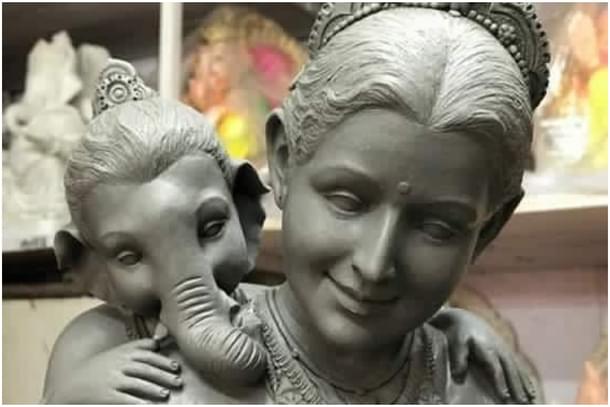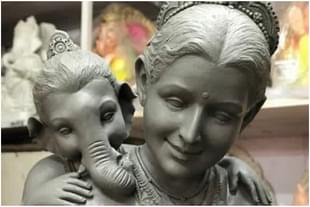Culture
She Connects The Womb To The Fetus, Brahman To Jiva: The Meaning Of 'Uma'
Aravindan Neelakandan
Oct 13, 2021, 09:13 PM | Updated 09:13 PM IST
Save & read from anywhere!
Bookmark stories for easy access on any device or the Swarajya app.


The Devas were rejoicing about their victories. The victories of the Devas are the moral and ethical wins. They are the victories over the senses and instincts. The victories for justice and liberty. As they rejoiced, they became egoistic.
Then, before them appeared a strange being. They wanted to know who he was. They sent Agni and Agni boasted of his ability to burn and consume anything. The strange being simply placed a blade of grass before Agni and asked him to burn it. Agni could not. Agni returned humbled.
Then went Vayu who too boasted of his ability to blow away anything and everything. The strange being again asked Vayu to move the blade of grass which Vayu could not.
Then came Indra himself and before him the Yaksha disappeared. To the confused Indra there appeared a beautiful woman in a resplendent form – She was the Goddess Uma. The golden-hued Himavati. [Kena Upanishad: 3:1-12 & 4:1-3]
She is the one who makes Indra understand that the Devas derive their power because they are grounded in Brahman.
Who is this Goddess Uma?
Prof. Sashi Bhusan Dasgupta in his monograph on the evolution of Mother worship in India writes:
Uma seems to be a word of very obscure origin, and proposed derivations are either arbitrary or esoteric. Thus, it has been held that the vowel u means Siva and ma means to measure: the goddess who measures Siva, that is the Shakti of Siva, is called Uma. Kalidasa says in his Kumara-sambhava that Parvati (the goddess as the daughter of the mountain) was dissuaded by her mother Menaka from resorting to austere penances for Siva with the words ‘u, ma’ (Oh, don’t) and hence is the name Uma for Parvati. The Harivamsha gives here original name as Aparna. The view that Uma represents a variant of the syllable Om (the Pranava) composed of the letters a, u and m and as such stands as the first symbol for the manifestation of the unmanifest, seem to be a later esoteric interpretation. The Babylonian Ummu or Umma, the Accadian Ummi and Dravidian Umma can be connected with each other and with Uma – all standing for the mother Goddess. In the coin of Huvishka the Goddess is found as ‘Ommo’.Evolution of Mother Worship in India, Advaita Ashrama, 2004, p.23
Prof. Das Gupta also points out that Sayanacharya explains the name Soma, of Taittiriya Aranyaka, as Shiva accompanied by Uma. Here Uma stands for ‘the knowledge of Brahman.’
Taking these and also the Kena Upanishad together, in which the Goddess appears as Uma-Himavati, a case can be made for the original name to be associated with what Prof. Das Gupta calls a ‘later esoteric interpretation.’
The Kena Upanishad the story is highly symbolic and one could say, even philosophically sophisticated. Swami Krishnananda Saraswati (1922-2001) of the Divine Life Society and a disciple of Swami Sivananda, points out that the three Devas made as actors in the Upanishad story namely Agni, Vayu and Indra represent the speech, prana and jiva respectively. While speech and prana return without success, the egoistic contained jiva cannot see the Brahman at all.
Brahman is considered the universal womb in Hindu spirituality. Through consciousness, the individual self grows spiritually inside the womb but it is the womb that sustains the fetus. Here the fetus does not get delivered separately but individuates to realize itself in its essence as the very womb that sustains it. What connects the fetus and womb is the placenta. If jiva is the fetus and Brahman is the womb then knowledge of Brahman is the placenta.
And that is what Uma is.
Sure enough one of the popular ancient Goddesses - from Turkey to Mongolia- was Umai the deified placenta. The Oxford Companion to World Mythology says this: ‘The first of the Siberian earth deities seems to have been an *Earth Mother who sits at the roots of the great axis tree. ... The ancient Turks worshipped *Umai (Umay), a childbirth goddess who was of primary importance and whose name meant 'source.' In Central-Asian Kyrgyzstan where She is ‘Umai Ene’, She is also the sacred fire goddess of the hearth apart from the Goddess of placenta.
What unites sacred fire and placenta? The wisdom.
Today, medical science speaks of ‘prescient placenta’ ( ‘The Scientist’, August 1, 2015). This is what Christopher Coe, who has been studying the primate placenta for years, has to write about what he has learnt:
The human placenta is the lifeline of the fetus. By bringing the maternal and fetal blood into contact, the placenta receives key nutrients and even delivers antibodies from the mother’s immune system to the developing baby. But placental communication is bidirectional, and the fetus also sends messages back to its mother via the organ. ... Placental communication also has a significant role in priming the immune system of the fetus, training it to tolerate certain stimuli and thereby preventing harmful reactions. ...
From the first moments of implantation to the provision of extra blood after delivery, the placenta is essential to fetal survival and infant well-being. While we are only just beginning to unravel the diverse secrets of the placenta, including how it first came into existence in our early mammalian ancestors, one thing is clear: the placenta must strike a delicate balance, buffering the fetus from external insults while conveying nutrients and information about the world and the mother’s state of health. ... Even from the perspective of biology, we should be in awe of how effectively the placenta nourishes and nurtures us during its brief life span. It prepares us to enter the world and even helps in the decision about when the time is right to make that critical leap.
Given the fact that the placenta is much more than a mere physical connection between the mother’s womb and the fetus, and is a dynamic interphase which is alive and even ‘prescient’ in its own way, no wonder the primordial human psyche saw in it the manifestation of divine feminine.
It also explains why it was Uma that provided the individuating jiva the wisdom of Brahman. If Uma is a Goddess derived from the archaic Umai the Goddess of the placenta, then it also stands to reason that why as connected to Pranava, she stands ‘as the first symbol for the manifestation of the unmanifest.’ It is not a later esoteric reading of the name. Rather it is the rediscovery of the older Goddess still residing in Uma Haimavati.
Incidentally, it is in the very ‘Dravidian’ Tamil alone that Uma is called Umai or Umaiammay, very close to Her supposedly Central Asian name. (That should actually make the advocates of Steppe-invaders hypothesis a little uncomfortable).
Aravindan is a contributing editor at Swarajya.




